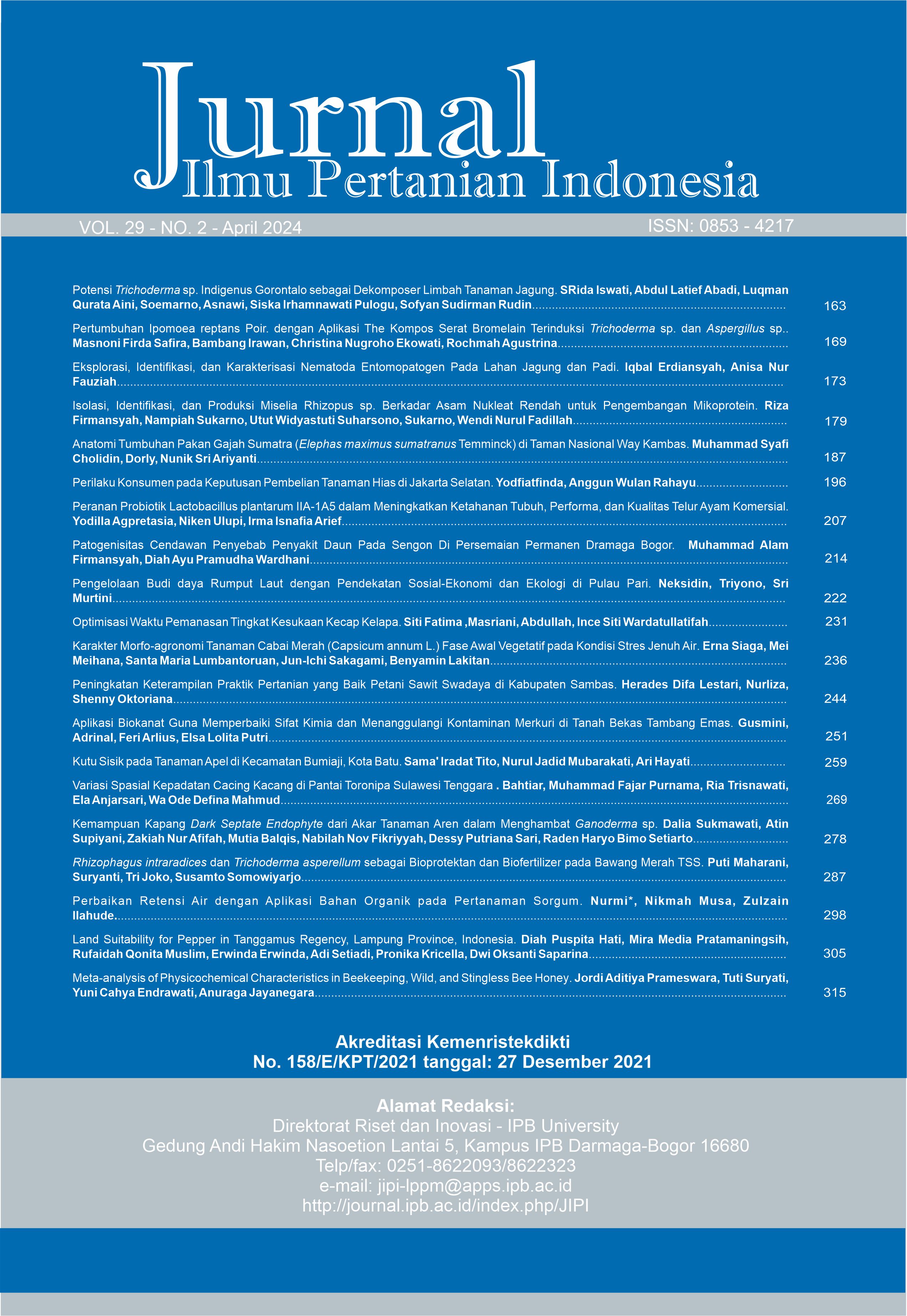Potensi Trichoderma sp. Indigenus Gorontalo sebagai Dekomposer Limbah Tanaman Jagung
Abstract
Using decomposers of fungi to increase the composting process is very necessary. The research aims to determine the potential of Trichoderma sp. Gorontalo local isolate as a decomposer of maize stover. The research was carried out from November 2022‒January 2023 at the Biological Agents Laboratory, Agricultural Plant Protection Center, Gorontalo Province Agricultural Department. This research determined the ability of six isolates of Trichoderma, namely TZ11DI1 (T. asperellum), TZ21BN2 (T. breviconvenctum), TZ21BT1 (T. virens), TZ12PO1 (T. ghanence), TZ21DU1 (T. reesei), TZ21LU1 (T. dorothopsis), and control (EM4) to produce cellulase and as a maize stover decomposer. The parameters observed were the clear zone in the isolate growing media as well as the physical and chemical characteristics of the compost produced. The results showed that Trichoderma isolates produced cellulase and potential as a decomposer for maize stover, as indicated by the ability to increase NPK nutrient levels and reduce the C/N ratio of maize stover compost.
Keywords: compost, decomposer, maize stover, Trichoderma
Downloads
References
Afrâa R, Sushant S, Ali F. 2016. Assessment of the composting process and compost’s utilization. Vegetos. An Int. J. Plant Res. 29, 2. https://doi.org/10.5958/2229- 4473.2016.00011.2.
Amira DR, Roshanida AR, Rosli MI, Zahrah SF, Anuar MJ, Adha CMN. Bioconversation of empty fruit bunch (EFB) and palm oil mill effluent (POME) into compost using Trichoderma virens. Afr. J. Biotechnol 10 (8): 18775-18780.
Budiastuti MTS, Purnomo D, Pujiasmanto B, Setyaningrum D. 2023. Response of maize yield and nutrient uptake to indigenous organic fertilizer from corn cobs. Agriculture 13, 309. https://doi.org/10.3390/agriculture13020309
Castillo-González, E, De Medina-Salas L, Giraldi-Díaz MR, Sánchez-Noguez C. Vermicomposting: A valorization alternative for corn cob waste. Appl. Sci. 2021, 11, 5692.
Carsolio C, Benhamou N, Haran S, et al. (1999) Role of the Trichoderma harzianum endochitinase gene, ech42, in mycoparasitism. Appl Environ Microbiol 65: 929–935.
Contreras-Cornejo HA, Macías-Rodríguez L, Del-Val E, et al. (2016) Ecological functions of Trichoderma spp. and their secondary metabolites in the rhizosphere: Interactions with plants. FEMS Microbiol Ecol 92: fiw036
Faesal, Syuryawati. 2018. Efektivitas kompos limbah jagung menggunakan bakteri dan cendawan pada tanaman jagung. Pangan 27(2); 117-128.
Gaind S, Nain L. 2007. Chemical and biological properties of wheat soil in response to paddy straw incorporation and its biodegradation by fungal inoculants. Biodegradation 18: 495-503.
Halifu S, Deng X, Song X, et al. (2019) Effects of two Trichoderma strains on plant growth, rhizosphere soil nutrients, and fungal community of Pinus sylvestris var. mongolica annual seedlings. Forests 10: 758.
Haq I, Shahzadi K, Hameed U, Javed MM, Qadeer MA. 2006. Solid¬state fermentation of cellulases by locally isolated Trichoderma harzianum for the exploitation of agricultural byproducts. Pak. J. Biol. Sci. 9:1779– 1782. doi:10.3923/pjbs.2006.1779.1782.
Hardianita S, Bosas R, Nurani Y (2016) The potential of Tithonia diversifolia green manure for improving soil quality for cauliflower (Brassica oleracea var. Brotrytis L.). J Degrad Min Lands Manag 3: 499–506.
Heny, A. 2015. Isolasi dan uji efektifitas aktivator alam terhadap aktivitas dekomposisi dan kualitas kompos tongkol jagung. http://thesis.umy.ac.id/datapublik/t60218.pdf
Herdiyantoro. 2010. Pengomposan: Mikrobiologi dan Teknik Pengomposan. Laboratorium Biologi dan Bioteknologi Tanah. Jurusan Ilmu Tanah. Fakultas Pertanian Universitas Padjadjaran.
Hsieh CWC, Cannella D, Jørgensen H, et al. (2015) Cellobiohydrolase and endoglucanase respond differently to surfactants during the hydrolysis of cellulose. Biotechnol Biofuels 8: 52
Irfan M, Nadeem M, Syed Q. 2014. One¬factor¬ata¬time (OFAT) optimization of xylanase production from Trichoderma viride¬IR05 in solid¬state fermentation. J. Radiat. Res. Appl. Sci. 7:317–326. doi:10.1016/J.JRRAS.2014.04.004.
Copyright (c) 2024 Asnawi, Rida Iswati, Abdul Latief Abadi, Luqman Qurata Aini, Siska Irhamnawati Pulogu, Sofyan S Rudin, Soemarno

This work is licensed under a Creative Commons Attribution-NonCommercial 4.0 International License.
This journal is published under the terms of the Creative Commons Attribution-NonCommercial 4.0 International License. Authors who publish with this journal agree to the following terms: Authors retain copyright and grant the journal right of first publication with the work simultaneously licensed under a Creative Commons Attribution-NonCommercial 4.0 International License. Attribution — You must give appropriate credit, provide a link to the license, and indicate if changes were made. You may do so in any reasonable manner, but not in any way that suggests the licensor endorses you or your use. NonCommercial — You may not use the material for commercial purposes.























